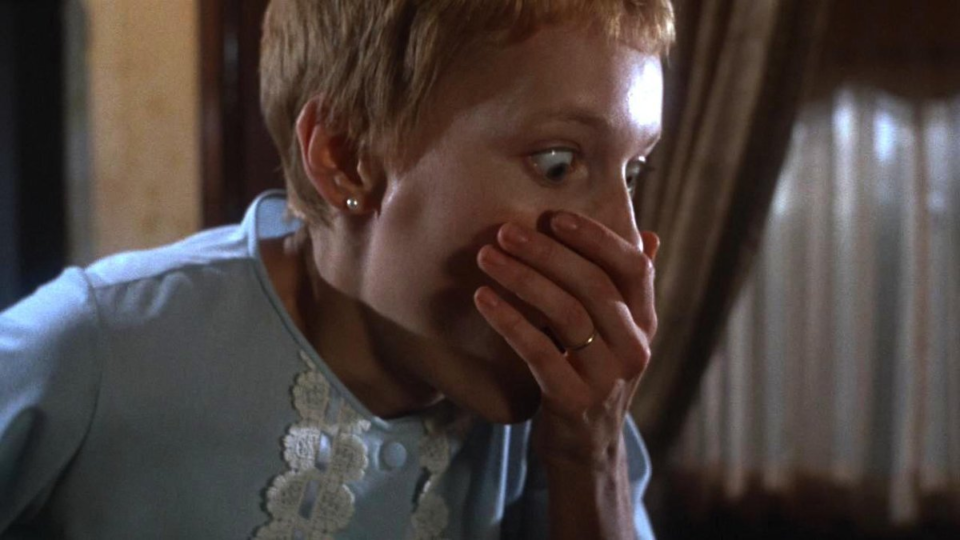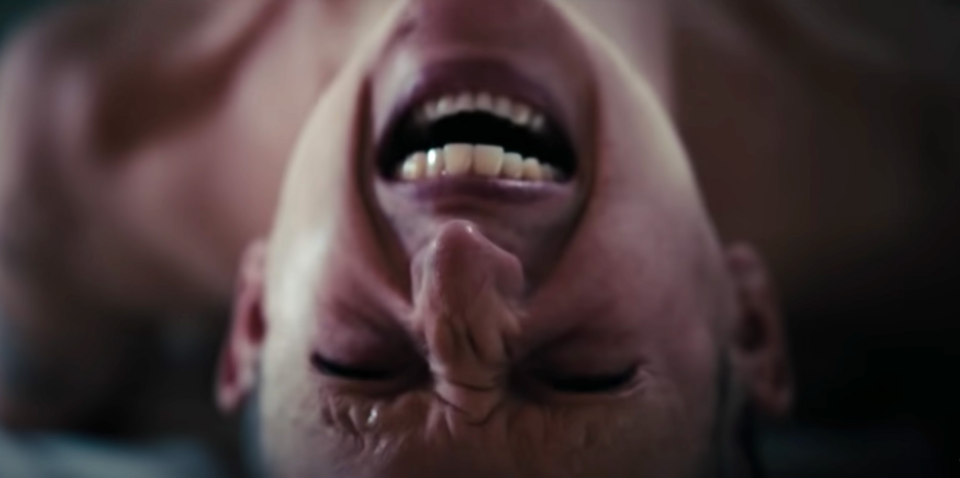The Body Horror of ‘Shiny Happy People’

In one of the early iterations of the Duggars’ infamous reality series—which detailed their hyper-conservative lifestyle through TLC’s sickly-sweet lens—Michelle Duggar, the mother to this army of Christian kids, is in labor with her 17th child. Through the opening five minutes of the season 2 episode entitled ‘Bringing Home Baby Duggar’, she is captured sitting staunchly, silently gripped by progressive contractions as she wanders across the family’s beige compound. A cutesy info bubble pops up explaining that “over the course of Michelle’s 16 pregnancies, she’s had about 7,680 contractions”.
Gradually the camera pulls back to frame Michelle’s labor through the eyes of her teenage daughters, all clad in long skirts, hair painstakingly curled, sitting across from their mother. While their eyes remain studiously fixed on her they are gripped by a curious emptiness. No doubt the endless cycle of child-rearing bore down on these young women, leaving smooth, vacant expressions in its wake.
Prime Video interrogates the terrifying implications of the Duggar’s reductive worldview in their new documentary series Shiny Happy People. The series maintains a laser-focus, leveling the majority of blame at the IBLP (Institute of Basic Life Principles), a Christian organization that valued faith and family (aka patriarchal authority structures). Shiny Happy People coils around a montage in the third episode, collecting the various Duggar women’s onscreen births over the show’s run. Jill Duggar explains in voiceover that she resisted being filmed before being reminded of her contractual obligations. She is caught blurrily being propped up by her husband, avoiding eye contact with the camera as she gives birth to her oldest son. All these scenes of labor are underlined by a breathless inescapability, so many people in such a small space with nowhere to go.
Revoking Bodily Autonomy and Rosemary’s Baby
Cinematically, it is reminiscent of the final act of Rosemary’s Baby, where the neighbors slip into the Woodhouse apartment before descending on the heavily pregnant Rosemary, crowding around with sudden, unshakeable tangibility, under the glaring, overhead lights, casting a surgical brightness that offers no shadows for Rosemary (or the Duggar women) to slink away privately.
What makes Rosemary’s Baby such a genre-defining piece of work is how Roman Polanski understands the instability of truth from his protagonist’s perspective. Once Rosemary locks herself into the house, safely isolated, the audience is lulled into momentary security before catching sight of neighbors shuffling through the background. Suddenly, their house, which was once unimpeachable, is stripped bare, riddled with inconsistencies and trap doors. The kind of darkness infecting this couple can’t be cast out by light, it isn’t relegated to shadows. Instead, it reorients the female protagonist’s world and paints everything in gruesome, bloody shades.

In many ways, Shiny Happy People reconfigures the Duggar’s reality show in a similar way—a final act twist. Once we are granted access to Jill’s painful experience, as an audience we are suddenly uncomfortably aware of the camera’s presence in these episodes, constricting around the pregnant women that it focuses on, obstructing rather than aiding the act at hand. We see Anna and Jessa Duggar panting on the corner of their double beds, with faceless hands holding them up, pushing their hair back. We see Rosemary Woodhouse held down by a horde, forcibly extracting her baby and fashioning it to suit their cause. Women rendered pawns in the push and pull of child delivery.
Isolation, Manipulation, and Mother!
While Rosemary’s Baby plays in the silent horror of the unknown, Darren Aronofsky’s Mother! allows the audience to live in a series of worst-case scenarios, mythically using the scope of the couple’s home to reflect on the world and the violence it unthinkingly inflicts on women. In the final 30 minutes of the film, Mother’s (Jennifer Lawrence) heavily pregnant body is thoughtlessly flung about, as the house fills up with people, transformed from an intimate dinner into a battleground. In the film’s climax, Mother’s son is taken and sacrificed to the crowds below, blood-soaked limbs torn apart and consumed in animalistic lunges. The film was deemed controversial for its broad religious imagery, but Shiny Happy People exists in a similar landscape, one firmly in the real world, where actions beget inexplicably extreme responses.
In featuring interviews with survivors of the IBLP, it becomes increasingly clear that one of this organization’s control tactics is to physically isolate their followers, blurring their ability to ascertain authority from truth. Lara Smith describes being locked in a furniture-less hotel room (labeled “the prayer room”) for four days after wearing heeled shoes deemed inappropriate. Directors Julia Willoughby Nason and Olivia Crist intersperse this with ads for the IBLP’s camps, grainy children form circles as a voiceover explains that “when the team leader raises three fingers, the children know that it is time to smile.”

At the end of Aronofsky’s thriller, Mother is forced to stay awake for days, clutching her son in an empty, ravaged bedroom, desperate to avoid the hungry masses outside who, in the end, kill her child anyway. Much like the religious leaders who locked Lara Smith in the prayer room, the horror of this moment lies in purposely and maliciously muddling the line where a person’s bodily autonomy ends, and the cruel, demanding world begins.
Then There’s Titane
Titane is a different kind of pregnancy story, equal parts violent and tender, transcending any easy definition. Alexia’s (Agatha Rousselle) relationship with her baby is expansive and slippery, encompassing everything human and inhuman. Through this, director and writer Julia Ducournau crafts a story that feels so distinctive, it could play out as a silent film, like a robotic ballet. In Anna Bogutskaya’s interview with Ducournau on the Final Girls podcast, Ducournau expands on how dance functions in her films: “…that for me, has always been the epitome of how body empathy is possible. How you can feel for someone just through your body and through their body.”

Under IBLP doctrine, dance was banned, thus banning access to people’s most innate, primal language. Yet Titane proves that it can also be a way of expressing care. Alexia and Vincent (Vincent Lindon) come to understand one another through a set of physical confrontations and dance scenes undercut by a sense of urgency and passion that paves the way for the final, terrifying, glorious childbirth. In many ways this is the opposite of the Duggar women’s birth experiences, each of them observed cruelly from a distance; viewers of Titane have been complicit in every bone-crunching development, learning the shape and rhythm of Alexia’s body. In those final moments, we are with them, watching as both characters are given access to a new piece of themselves, far away from any prying eye.
Horror argues that our sense of self is easily infringeable. It points the harsh spotlight at our most intimate corners with unnerving ease. But religions have taken advantage of this for centuries, slowly severing people from parts of their bodies, limbs offered up to the world in acts of horrible, eye-catching self-immolation. Shiny Happy People affirms this, arguing that for women in the IBLP, living under such strict Christian doctrine has always been an act of brutal, bloody survival.
Categorized:News

